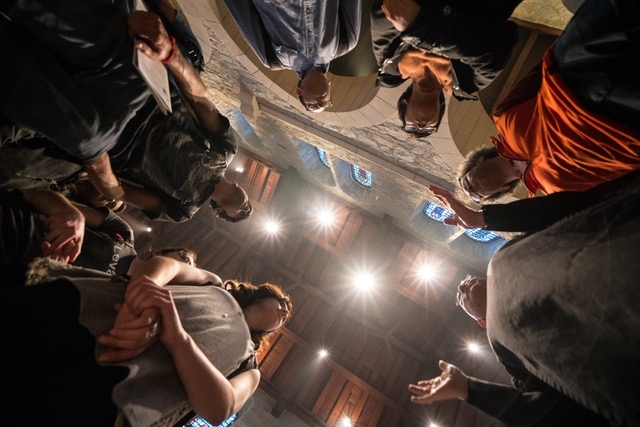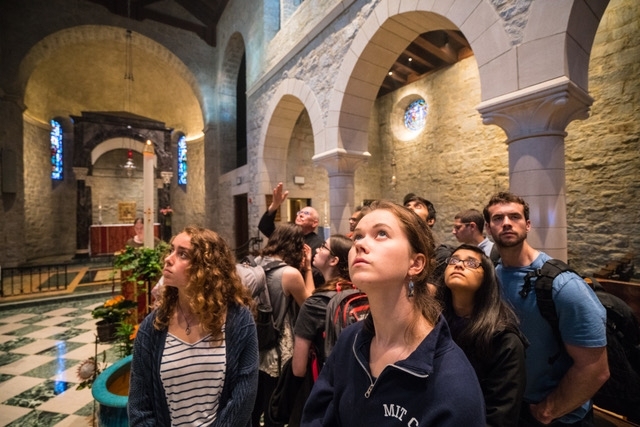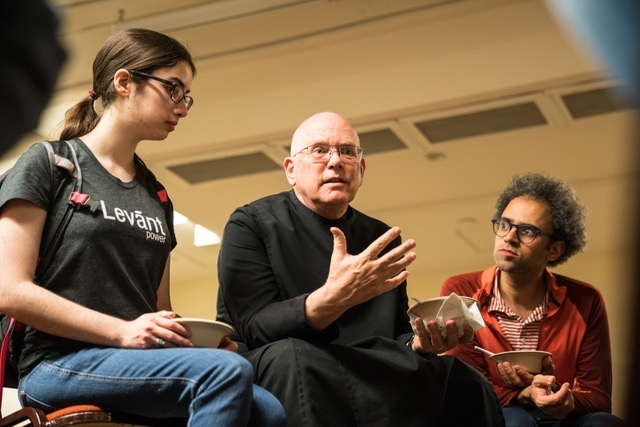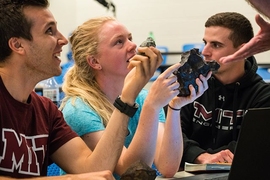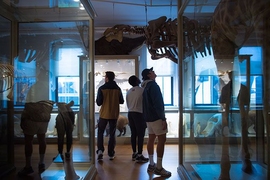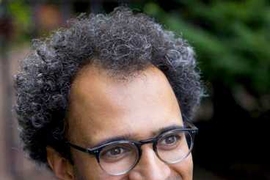Zareen Choudhury and her friends have yet to pinpoint the meaning of life, but it’s not for lack of trying. Dorm study sessions often veer off into more abstract territory — and once they get going, hours go by, p-sets are forgotten, and nailing down answers to life’s persistent questions is all that matters.
“Many of us at MIT have these deep, late-night conversations about the grander purpose of our existences,” says Choudhury, a senior in electrical engineering and computer science. She never expected MIT to offer a classroom forum for those debates, but then she came across a new anthropology course. Course 21A.157 (The Meaning of Life), examines how a variety of cultural traditions approach the question of how to live a meaningful life. “It seemed fascinating to have a structured and guided discussion forum for that conversation,” she says.
The faculty who created the course, Graham Jones and Heather Paxson, say they recognized a widespread hunger for self-reflection and shared dialogue among students. Their course explores how people grapple with meaning in their daily lives and communities through various cultural traditions. By looking at different social and historical practices, students develop tools for thinking about moral concerns.
“I love the personal aspect. I don’t necessarily get that with my technical classes,” says Choudhury. “I compare my own experiences with case studies from class. It gives me new perspectives on questions I’ve always grappled with — and that enriches my life.”
What does a better world really look like?
One of the choreographers of the class, Paxson, who is the William R. Kenan, Jr. Professor of Anthropology and a Margaret MacVicar Faculty Fellow, remembers a recent discussion in 21A.157 around a unit on work and meaning. Students steered their attention toward MIT’s often-articulated mission to bring knowledge to bear on the world’s great challenges.
“Students hear all the time that they’re going to change the world,” Paxson says. “They feel a lot of pressure. They want to explore what that really means. How do you change the world for the better? What does it mean to do that well?”
Jones, an associate professor of anthropology, nods enthusiastically. Earlier he and Paxson had led the class down the bustling Infinite Corridor and ducked into a light-filled room featuring a floor mural by modernist Sol LeWitt. “Let’s just spend a quiet moment here,” Jones had said. Now he and Paxson are watching the students earnestly trying to relax. “They are learning to carve out time for reflection,” he says.
The LeWitt visit marks the final minutes of a lively class that had centered on how the Western Apache Indians of Arizona learn moral lessons by reflecting on the landscape around them. “What does wisdom mean to the Apache?” Jones had asked. “How do they create meaning through stories about places? How do they use places to make sense of the world?” Students then volunteered examples from literature, art, and popular culture that resonate with their own pursuit of meaning. Now, it seems, the LeWitt gallery is resonating, too.
When asked for his take on the popularity of this class, which is so well-attended tardy students are often left standing in the back of the packed classroom, Jones tells a story. A few years ago, a student told him excitedly about a UROP (Undergraduate Research Opportunities Program) experience doing lab research on radically extending human life. Jones asked the student about the ethical implications of the work, and its potential effects on the meaning of life. The student was stunned. Until he was asked, he simply hadn’t considered those dimensions. He was swept up in the thrill of chasing his experimental results. Until that moment, science was all.
Matthew Ryback, an aeronautical and astronautical engineering senior currently enrolled in 21A.157, says MIT students need a push toward reflection. He says the exposure to ethnographies about people worldwide has changed the way he thinks. “You see how people derive meaning from their lives, and you reflect on your own life, potentially changing it for the better.”
Time out
Near the end of the semester, Jones invites students to visit the Society of Saint John the Evangelist, a monastery just down Memorial Drive from the MIT campus, with sprawling gardens, striking architecture, and clergy who spend much of their time in silent contemplation.
The students observe a service. For first-year student Loewen Cavill, the rhythm of the prayers, the ornate high ceilings, and the incense thick in the air get her thinking about religious services she attended with her family back home. When they chat with the brothers after the service, Cavill notes quietly, “I notice a difference in myself. I see that I’ve changed.”
In the broadest sense, of course, this is exactly what college is for: to make you unfamiliar to yourself, to open up new spaces of understanding through the introduction of knowledge of all kinds. What 21A.157 offers is both broad and personal enough to stand in some contrast to, say, thermodynamics. Students read cross-cultural studies of family, wealth, sexuality, community, and faith, seeing in them points of both familiarity and eye-opening difference.
Sometimes, as in Cavill’s case, new awareness happens in a moment, through an interaction with a place. She had studied the Apache practice of reflecting on morally significant places, but now she had experienced something like it herself — and on some level, the “meaning” of her life had just changed. She was not alone. A third-year electrical engineering and computer science student, Rachel Thornton, tells Brother David Vryhof: “All of this is very different than normal MIT life. We don’t have these scheduled moments to stop and think.”
“Now you know where we are,” says Vryhof, a soft-spoken man in long black robes. “This is a place that is quiet and peaceful, and you can come here and do that kind of thinking.”
“The Meaning of Life” is a course name that appears to promise a lot. But the professors are lighthearted about the wording — it serves to draw the attention of engineering and science students. “It’s not really the meaning of life. We’re not answering eternal questions. We’re thinking about how people around the world seek meaning,” says Paxson. “Students jump into these conversations. They want to make room for reflection.”
